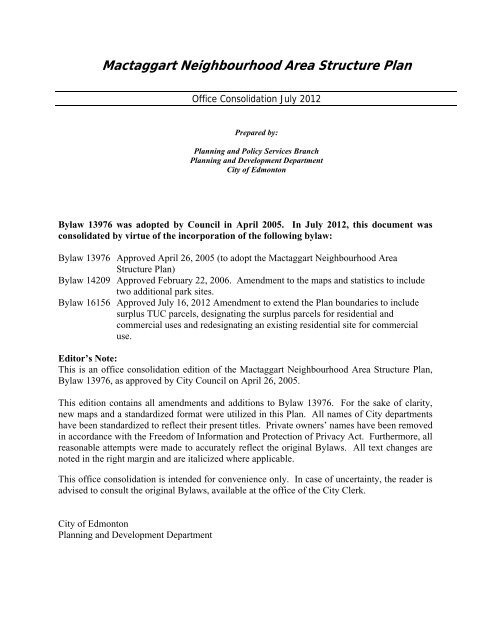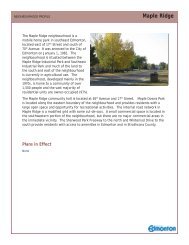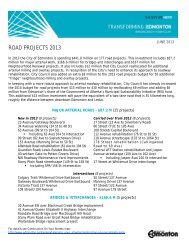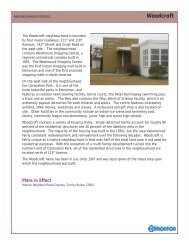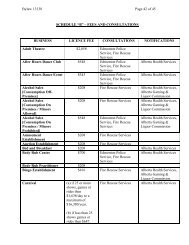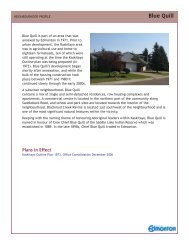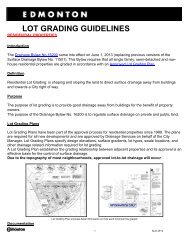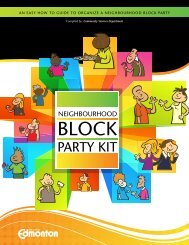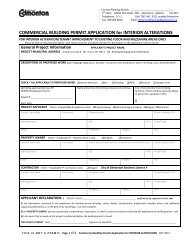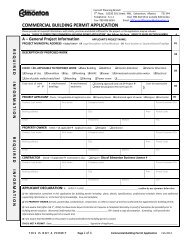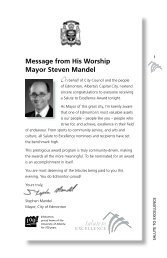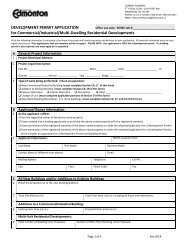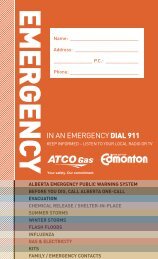Mactaggart Neighbourhood Area Structure Plan - City of Edmonton
Mactaggart Neighbourhood Area Structure Plan - City of Edmonton
Mactaggart Neighbourhood Area Structure Plan - City of Edmonton
You also want an ePaper? Increase the reach of your titles
YUMPU automatically turns print PDFs into web optimized ePapers that Google loves.
TABLE OF CONTENTS<strong>Mactaggart</strong> NSP MapNSP Statistics1.0 Introduction1.1 Purpose1.2 Boundary <strong>of</strong> <strong>Plan</strong> <strong>Area</strong>1.3 Land OwnershipP1235552.0 Site Context and Development Considerations2.1 Topography2.2 Soils2.3 Surface Drainage2.4 Vegetation and Natural <strong>Area</strong>s2.5 Existing Land Use2.6 Existing Roadways2.7 Pipeline Facilities2.8 Geotechnical Conditions2.9 Historical and Archaeological Resource2 10 Environmental Impact Assessment3.0 Policy Context and Design Considerations3.1 Municipal Development <strong>Plan</strong>3.2 Terwillegar Heights Servicing Concept Design Brief3.3 North Saskatchewan River Valley <strong>Area</strong> Redevelopment <strong>Plan</strong>3.4 Smart Choices3.5 Stormwater Management Design Guidelines3.6 Top <strong>of</strong> Bank Policy3.7 Crime Prevention Through Design3.8 Suburban <strong>Neighbourhood</strong> Design Principles888881010101213131414141616161717
4.0 Development Goals, Objectives and Design Principles4.1 <strong>Neighbourhood</strong> Goals4.2 Development Objectives4.3 Design Principles5.0 The Development Concept5.1 The Development Concept5.2 Land Use Distribution6.0 Transportation6.1 The Roadway Network6.2 Pedestrian and Bicycle CirculationPage191919192323253030317.0Engineering Services7.1 Provision <strong>of</strong> Utility Services7.2 Sanitary Drainage7.3 Stormwater Drainage7.4 Water Servicing7.5 Shallow Utilities3333333335358.0 <strong>Plan</strong> Implementation8.1 Staging <strong>of</strong> Development8.2 Subdivision and RezoningAppendix-Land Use and Demographic Pr<strong>of</strong>ile38383841
List <strong>of</strong> Figures:PageFigure 1 - Location Map 4Figure 2 - Context Map 6Figure 3 - Land Ownership 7Figure 4 - Topography 9Figure 5 - Existing Surface Features 11Figure 6 - Development Concept 24Figure 7 - Circulation 32Figure 8 - Sanitary Servicing 34Figure 9 - Storm Drainage 36Figure 10 - Water Servicing 37Figure 11 - Staging 39
Bylaw 16156, Approved July 16, 2012Office Consolidation July 2012 1
MACTAGGART NEIGHBOURHOOD AREA STRUCTURE PLANAPPROVED LAND USE AND POPULATION STATISTICSBYLAW 16156<strong>Area</strong> (ha)% <strong>of</strong> GDAGross <strong>Area</strong> 101.9Gas & Pipeline ROW 1.0Gross Developable <strong>Area</strong> (GDA) 100.9 100.00Stormwater Management Facilities 5.9 5.8Park 7.8 7.7Walkways 0.7 0.7Circulation 22.6 22.4Net Developable <strong>Area</strong> 63.9 63.3Commercial 6.4 6.4Total Net Residential 57.5 57.0<strong>Area</strong>DwellingUnits/haUnitsPersons/UnitPopulationLow Density Residential 43.2 22 951 2.8 2,662Medium Density Residential 4.1 45 184 2.8 514Row Housing (RF5)Low Rise Apartment (RA7) 10.2 90 918 1.8 1652Total Residential 57.05 2,052 4,829Density:Housing Mix35.7 units / net residential ha46% Low Density Residential/ 54% Medium Density ResidentialSTUDENT GENERATIONSTATISTICSPublic Separate TotalGrades K-8 713 218 931Grades 9-12 254 85 339Totals 967 303 1,270Office Consolidation July 2012 2
1.0 Introduction1.1 PurposeThe purpose <strong>of</strong> this <strong>Neighbourhood</strong> <strong>Area</strong> <strong>Structure</strong> <strong>Plan</strong> (NASP) is to establish ageneral land use framework for the development and servicing <strong>of</strong> the landsidentified within the boundaries <strong>of</strong> the <strong>Mactaggart</strong> <strong>Neighbourhood</strong>. <strong>Mactaggart</strong> isone <strong>of</strong> seven neighbourhoods located in Terwillegar Heights, a suburbancommunity in southwest <strong>Edmonton</strong>. More specifically, <strong>Mactaggart</strong> is situated east<strong>of</strong> Rabbit Hill Road, south <strong>of</strong> <strong>Mactaggart</strong> Drive and west <strong>of</strong> Whitemud Creek (seeFigure 1 — Location Map).The proximity <strong>of</strong> the plan area to the Whitemud Creek ravine and Anthony HendayDrive presents an opportunity to maximize the community's biophysical, social andinfrastructure assets to create a neighbourhood that is well integrated into thesurrounding landscape and urban pattern <strong>of</strong> the Terwillegar Heights community.Reflecting a diversity <strong>of</strong> statutory and non-statutory influences, the<strong>Neighbourhood</strong> <strong>Plan</strong> will implement the development concept and land use patternestablished for the neighbourhood, including the type, density and distribution <strong>of</strong>various land uses, transportation modes, servicing schemes and sequence <strong>of</strong>development.The <strong>Mactaggart</strong> <strong>Neighbourhood</strong> <strong>Area</strong> <strong>Structure</strong> <strong>Plan</strong> has been prepared in generalconformance with the Municipal Development <strong>Plan</strong>, the Terwillegar HeightsSCDB, and other relevant municipal policies and design principles furtherdescribed in Chapter 3.To strengthen the neighbourhood plan concept, a minor deviation from theTerwillegar Heights SCDB will be handled through an amendment to the DesignBrief for consideration concurrently with this <strong>Neighbourhood</strong> <strong>Plan</strong>.This plan will be used as a tool to guide the future development and subdivision<strong>of</strong> lands in an orderly and effective manner. Over time, it is envisaged that theimplementation <strong>of</strong> these policies and principles will result in a healthy, sustainableand dynamic neighbourhood where people would like to reside.Office Consolidation July 2012 3
Office Consolidation July 2012 4
1.2 <strong>Plan</strong> Boundary<strong>Mactaggart</strong> is located at the southernmost tip <strong>of</strong> the Terwillegar Heightscommunity, adjacent to the Transportation and Utility Corridor and the WhitemudCreek. The neighbourhood covers an area <strong>of</strong> approximately 101.9 hectares andconsists <strong>of</strong> a number <strong>of</strong> parcels ranging in size from 1.3 ha to 32 ha.Bylaw 16156July 16, 2012As illustrated on Figure 2 - Context Map, the neighbourhood is bounded on the:a) west by the planned future alignment <strong>of</strong> Rabbit Hill Road (142 Street) andthe adjacent neighbourhood <strong>of</strong> South Terwillegar;b) north and east by the southern boundary <strong>of</strong> the Magrath Heights NASPplan area;c) southwest by the Transportation and Utility Corridor (TUC); and on thed) southeast by the ravines <strong>of</strong> Whitemud Creek, a tributary <strong>of</strong> the NorthSaskatchewan River.1.3 Land OwnershipThis <strong>Plan</strong> was prepared on behalf <strong>of</strong> the four private developers within the planarea.Amended by EditorThe distribution <strong>of</strong> land ownership within the plan area is shown on Figure 3 -Land Ownership and summarized quantitatively on Table 1.Table 1 — Land Ownership (As amended by Editor)Land Owner Legal Description <strong>Area</strong>1. Private Developer Portion <strong>of</strong> North Half <strong>of</strong>SW 1 /4 36-51-25-49.59 hectares2. Private Developer Portion <strong>of</strong> South Half <strong>of</strong> 31.91 hectaresSW 1 /4 36-51-25-43. Private Developer Block 4, <strong>Plan</strong> 8922220 24.28 hectares4. Private Developer Portions <strong>of</strong> East Half <strong>of</strong> 31.49 hectaresSection 26-51-25-45. <strong>City</strong> <strong>of</strong> <strong>Edmonton</strong> Government Road Allowance 1.32 hectaresTotal <strong>Plan</strong> <strong>Area</strong>98.59 hectaresOffice Consolidation July 2012 5
Office Consolidation July 2012 6Bylaw 16156, Approved July 16, 2012
1. Portion <strong>of</strong> North Half<strong>of</strong> SW ¼ 36-51-25-42. Portion <strong>of</strong> South Half<strong>of</strong> SW ¼ 36-51-25-43. Block 4, <strong>Plan</strong>89222204. Portions <strong>of</strong> East Half<strong>of</strong> Section 26-51-25-4Bylaw 16156, Approved July 16, 2012Office Consolidation July 2012 7
2.0 Site Context and Development Considerations2.1 TopographyThe topography <strong>of</strong> the plan area consists <strong>of</strong> a relatively flat tableland that slopesfrom a high point at the north edge to a low point at the southernmost extremity <strong>of</strong>the area. As depicted by the contours in Figure 4 – Topography, elevations on thetableland range from approximately 697.5 metres in the north to approximately685.0 metres in the south. Bordering the southeastern edge <strong>of</strong> the <strong>Plan</strong> area are therelatively steep banks <strong>of</strong> the Whitemud Creek with three natural drainage channelspenetrating the tableland along the west edge <strong>of</strong> the ravine.2.2 SoilsThe existing soils within the plan area consist <strong>of</strong> a mixture <strong>of</strong> moderately to welldrainedOrthic Black and Gleyed Black Chernozemic soils which lie upon a base <strong>of</strong>Glaciolacustrine clay, sand, gravel materials and bedrock. The soil conditionsshould provide a satisfactory base for urban development.2.3 Surface DrainageSurface drainage within the plan area reflects the influence <strong>of</strong> the topographyhighlighted in Figure 4. In general the drainage pattern follows the gentle slope <strong>of</strong>the tableland east toward Whitemud Creek ravine, and south towards the naturallydefined drainage channels which penetrate the tableland along the edge <strong>of</strong> theravine. The topography and direction <strong>of</strong> flow will have some implications for thedesign <strong>of</strong> engineering services.2.4 Vegetation and Natural <strong>Area</strong>With the exception <strong>of</strong> a few hedgerows that exist near the north-south GovernmentRoad Allowance and the former farmstead on the property owned by a privatedeveloper (portions <strong>of</strong> east half <strong>of</strong> section 26-51-25-4), the upland is devoid <strong>of</strong> anysignificant vegetation, having been cleared for agricultural purposes during decades<strong>of</strong> cultivation. Mature and healthy trees within the hedgerows may present someopportunity for integration with adjacent residential use, or as a shelterbelt forpedestrian walkways.Amended by EditorOn the eastern edge <strong>of</strong> the neighbourhood, the slopes and ravines <strong>of</strong> the WhitemudCreek are vegetated with native plant species and classified as a Significant Natural<strong>Area</strong>. This bio-diversity <strong>of</strong> this plant habitat will be protected from urbandevelopment through the designation <strong>of</strong> the area as Environmental Reserve andapplying the (A)-Metropolitan Recreation Zone in accordance with the NorthSaskatchewan River Valley ARP and the Top <strong>of</strong> Bank Policy.Office Consolidation July 2012 8
Office Consolidation July 2012 9Bylaw 16156, Approved July 16, 2012
2.5 Existing Land UseAs noted earlier, the majority <strong>of</strong> lands with the neighbourhood are used foragricultural purposes. This activity will be phased out as development proceeds.The cluster <strong>of</strong> older structures comprising the remnants <strong>of</strong> the farmstead locatednear the south end <strong>of</strong> the plan area, and shown on Figure 5-Exisiting SurfaceFeatures, will be demolished and the area will be assessed to ensure its suitabilityfor urban development.The neighbourhood has two other significant features, a major pipeline Right-<strong>of</strong>-Way and a Government Road Allowance (portion <strong>of</strong> 142 Street arterial). Theseright-<strong>of</strong>-ways pose no major constraints development. Opportunities forneighbourhood use are discussed in detail below.2.6. Existing RoadwaysSouth <strong>of</strong> the Pipeline R.O.W is a portion <strong>of</strong> 142 Street, a Government RoadAllowance (GRA) that provided access to the farms in the area. The GRA will beretained and used as roadway, public walkway or park space, where feasible orpractical. Unused portions <strong>of</strong> the GRA will be closed and incorporated into futuresubdivisions within the plan area.Amended by EditorThe GRA south <strong>of</strong> the neighbourhood has been closed to through traffic to facilitatedevelopment <strong>of</strong> Anthony Henday Drive within the TUC.2.7 Pipeline FacilitiesAs shown on Figure 5-Exisiting Surface Features, the neighbourhood is traversedeast to west by a 15 m wide high pressure gas pipeline R.O.W. operated by aprivate corporation. According to the owner, the transmission facility is expectedto remain in its present location indefinitely. The pipeline R.O.W. will be used as amajor open space landscaped corridor providing pedestrian connections within theneighbourhood and to other parts <strong>of</strong> the Terwillegar Heights community.Amended by EditorThese improvements will be incorporated into the future pattern <strong>of</strong> subdivisionwithin the plan area in accordance with <strong>City</strong> <strong>of</strong> <strong>Edmonton</strong> policies, and the number<strong>of</strong> roadway crossings <strong>of</strong> the pipeline will be minimized. Other existing pipelinefacilities within the plan area that are considered minor service lines will beabandoned or relocated as part <strong>of</strong> the future development process.A review <strong>of</strong> information provided by the Energy and Utilities Board indicate thatthere are no active or suspended oil wells within the boundaries <strong>of</strong> the <strong>Mactaggart</strong>neighbourhood.Office Consolidation July 2012 10
Office Consolidation July 2012 11Bylaw 16156, Approved July 16, 2012
2.8 Geotechnical ConsiderationsHistorical data on the area has revealed that coal deposits were mined to someextent along the north banks <strong>of</strong> the Whitemud Creek several decades ago. To ensuredevelopments on the tableland will not be affected by this past activity, two detailedgeotechnical investigations were undertaken by Thurber Engineering Ltd. in 2002entitled:a) "Development Setback Assessment and Geotechnical Assessment <strong>of</strong> Impact<strong>of</strong> Former Coal Mines" for Block 4, <strong>Plan</strong> 8922220 dated November 20, 2002;andb) "Geotechnical Assessment <strong>of</strong> Impact <strong>of</strong> Former Coal Mines" for portions <strong>of</strong>the east half <strong>of</strong> section 26-51-25-4, dated July 12, 2002.Based on the assessment for Block 4, <strong>Plan</strong> 8922220, the Report, in summary,recommends that:• Site development guidelines to be considered when future subdivisions areproposed adjacent to the ravine bank to manage surface drainage.• A development setback distance from the top-<strong>of</strong>-bank line <strong>of</strong> 20 metres isrecommended for the southern slope, and 10 metres is recommended for theeastern slope.• The setback areas between the top-<strong>of</strong>-bank line and development line shouldconsist <strong>of</strong> natural vegetation. Where the natural vegetation has been removed,revegetation should be encouraged to protect the setback area and slope. Thevegetation should be native to the area with species chosen which have deeproot systems that do not require extensive watering. Irrigation should only beallowed during initial growth but not after establishment <strong>of</strong> the vegetation.• Residential subdivision development over the underground mine workings isconsidered feasible.Similarly, the geotechnical report prepared regarding the portions <strong>of</strong> the east half <strong>of</strong>section 26-51-25-4 concludes that:• Residential subdivision development over the underground mine workings onthose lands is considered feasible.Amended by EditorAmended by EditorAmended by EditorAmended by EditorAdditional geotechnical information for any <strong>of</strong> the areas affected by the former coalmines may be required at the zoning and/or subdivision stages to ensure that slopestability will not be affected by urban development.Office Consolidation July 2012 12
This will be determined in consultation with the Transportation and Streets and the<strong>Plan</strong>ning and Development Departments.2.9 Historic and Archaeological ResourceIn December 2003, a Phase 1 - Historical Overview <strong>of</strong> the <strong>Mactaggart</strong>neighbourhood (called Terwillegar East at that time) was prepared by Terrance H.Gibson from Alberta Western Heritage Inc. on behalf <strong>of</strong> a private developer. Theconclusions and recommendations <strong>of</strong> this report noted that the eastern portion <strong>of</strong> the<strong>Mactaggart</strong> neighbourhood required further archaeological assessment prior to anyground disturbance taking place. The report identified two areas <strong>of</strong> potentialconcern adjacent to the plan area, within the Whitemud Creek Ravine area.Amended by EditorAs a follow up to that recommendation, a Historical Resources Impact Assessmentwas also completed by Stantec Consulting in 2004. The Report identified two areaswithin the adjacent Environmental Reserve in the Whitemud Creek Ravine thatwere former campsites and may require further HRIA testing if there is impact fromthe proposed ravine trail system.Alberta Community Development (ACD) has advised that clearance has beengranted for the development <strong>of</strong> the <strong>Mactaggart</strong> plan area under the HistoricalResources Act. ACD also advises that, pursuant to Section 31 <strong>of</strong> the HistoricalResources Act, development proponents and their representatives are required toreport the discovery <strong>of</strong> any archeological, historic period or paleontologicalresources which may be encountered during construction.2.10 Environmental Site AssessmentsFour separate Phase I Environmental Site Assessments were undertaken by StantecConsulting Ltd. for the plan area. The four reports covered the following areas: Report #1, August 2003 (NE 26-51-25-4, SE 26-51-25-4) Report #2, November 2001 (a portion <strong>of</strong> the south half <strong>of</strong> SW 36-51-25-4) —update April 2004 Report #3, June 2003, (<strong>Plan</strong> 8922220, Block 4)Amended by Editor Report #4, February 2004, (a portion <strong>of</strong> the north half <strong>of</strong> 36-51-25-4)These reports have been submitted under separate cover. Given the largelyagricultural history <strong>of</strong> the land, there are no significant outstanding concerns for thelands in the plan area. However, there were two areas located near the farmstead inthe southeast portion <strong>of</strong> the area covered by Report #1, that were identified aspotential areas <strong>of</strong> environmental concern. Further investigation and updates will becompleted prior to the zoning and subdivision stages <strong>of</strong> development.Office Consolidation July 2012 13
3.0 Policy Context and DesignConsiderationsThe <strong>Mactaggart</strong> NASP has been prepared having regard not only to physiographicinfluences but also to statutory plans, policies and design principles thatgovern land development in the <strong>City</strong> <strong>of</strong> <strong>Edmonton</strong>, including the <strong>Edmonton</strong>Municipal Development <strong>Plan</strong> (MDP), Terwillegar Heights Servicing ConceptDesign Brief (SCDB), the <strong>City</strong> <strong>of</strong> <strong>Edmonton</strong> Suburban <strong>Neighbourhood</strong> DesignPrinciples and other relevant municipal planning policies.The following sub-sections summarize the salient policies and design principlesthat influence the development <strong>of</strong> <strong>Mactaggart</strong> as a sustainable neighbourhood.Applicants seeking amendments to the neighbourhood plan or applying forrezoning, subdivisions or development permits are required to consult the actualdocuments for specific guidance on detailed requirements as they apply toparticular properties.3.1 The Municipal Development <strong>Plan</strong><strong>Plan</strong> <strong>Edmonton</strong> - The <strong>City</strong> <strong>of</strong> <strong>Edmonton</strong>'s Municipal Development <strong>Plan</strong> (MDP)provides a policy framework to guide the <strong>City</strong>'s growth and economicdevelopment to sustain <strong>Edmonton</strong>'s quality <strong>of</strong> life and resource for the benefit <strong>of</strong>its citizens. To manage land use and development in the suburbs, the MDPdesignates this community as a suburban area suitable for urban development.The MDP also emphasizes that new growth in suburban areas will beaccommodated in a fiscally responsible manner; be cost effective in the use <strong>of</strong> land,infrastructure and services by promoting compact and contiguous development,among other strategies.The <strong>Mactaggart</strong> NASP supports <strong>Plan</strong> <strong>Edmonton</strong>'s strategies for managing suburbangrowth by accommodating development in an orderly, serviced and cost-effectivemanner; by providing for a range <strong>of</strong> housing types and densities, and by providingadequate recreational facilities, public open spaces and natural areas to createliveable communities in the suburbs.3.2 Terwillegar Heights SCDBThe Terwillegar Heights SCDB provides general guidelines to facilitatedevelopment <strong>of</strong> neighbourhoods within the SCDB plan area. The followingsummary highlights how these guidelines have been applied in the <strong>Mactaggart</strong>NASP:The SCDB recommends that:Office Consolidation July 2012 14
• "A variety <strong>of</strong> housing types at various densities should be provided to meetthe needs <strong>of</strong> diverse residents and to achieve a balanced and integratedsocial structure."The <strong>Mactaggart</strong> NASP proposes a variety <strong>of</strong> housing types at various densitiesincluding single and semi-detached housing, row housing, stacked row housingand low rise apartments distributed to take advantage <strong>of</strong> neighbourhood amenitiessuch as the Stormwater lakes, pipeline right-<strong>of</strong> way and the commercial area."Additional Employment Opportunities should be planned to <strong>of</strong>fer a range<strong>of</strong> options."The southern portion <strong>of</strong> the <strong>Mactaggart</strong> NASP incorporates a <strong>Neighbourhood</strong>Commercial Centre which will provide local employment opportunities rangingfrom local to community level services. Possible uses include convenience stores,gas bars, grocery stores, doctor or dentist <strong>of</strong>fices and postal outlets. Home businessactivities are also possible under the Zoning Bylaw in all applicable residentialareas."Transportation alternatives should foster improved opportunities for nonmotorizedmeans <strong>of</strong> travel within the study area."The neighbourhood has been planned to encourage both walking and cycling, Itincludes a series <strong>of</strong> linked walkways allowing for pedestrian traffic to access theschool site and other facilities from within as well as from the adjacentneighbourhoods. A major pedestrian linkage will be provided in the east/westpipeline right-<strong>of</strong>-way. There is also an extensive network <strong>of</strong> bicycle and pedestrianwalkways linking to the surrounding neighbourhoods, and the Top-<strong>of</strong>-Bankroadway/walkway."An activity focus for the neighbourhood should <strong>of</strong>fer a range <strong>of</strong> functions,services, and activities that will bring local residents into the specializedarea."A commercial/medium density residential complex bordering a storm water lake isproposed at the south entrance to the neighbourhood. The medium densityresidential uses will provide a local population base that will reinforce the focalpoint functions <strong>of</strong> commercial uses in the activity centre."The natural topography and environment should be protected andenhanced for both environmental and marketing reasons."The <strong>Mactaggart</strong> neighbourhood is designed to take advantage <strong>of</strong> its proximity to theWhitemud Creek and its ravines by ensuring that developments are setbackadequately from the escarpment, by designating the ravines and natural areas asEnvironmental Reserve and by providing view point parks and low impactpedestrian linkages to ecologically sensitive areas"A variety <strong>of</strong> urban design features should be incorporated into the plan tocreate a more human scale living environment."Office Consolidation July 2012 15
The design <strong>of</strong> the commercial, civic and medium density developments will bedesigned to reflect a more human scaled architecture with adequate setbacks,orientation, landscaping and pedestrian scaled lighting, signage and street furniture.<strong>Neighbourhood</strong> parks, pedestrian linkages and bicycle routes will be incorporatedinto the pattern <strong>of</strong> development to assist in the creation <strong>of</strong> a more human scaleliving environment.3.3. North Saskatchewan River Valley <strong>Area</strong> Redevelopment <strong>Plan</strong>The <strong>Mactaggart</strong> NASP area is bounded on the east by the Whitemud CreekRavine, which is part <strong>of</strong> the North Saskatchewan River Valley and Ravine system.The <strong>Mactaggart</strong> NASP will ensure that the policies <strong>of</strong> the North SaskatchewanRiver Valley ARP, particularly with respect to adjacent use, linkages, the Top <strong>of</strong>Bank Policy and the recommendations <strong>of</strong> required geotechnical assessment for theinterface between the <strong>Mactaggart</strong> neighbourhood and the River Valley ARP area,are adhered to.3.4 Smart ChoicesIn March 2004, <strong>City</strong> Council approved a set <strong>of</strong> "Smart Choices" recommendationsthat forms the key principles to build vibrant, sustainable communities. "SmartChoices" encourages transit- oriented developments, neighbourhood reinvestment,residential infill, urban design, commercial redevelopment,consultation and education, and a walkable community. Two <strong>of</strong> the eightinitiatives have a strong influence in the design <strong>of</strong> <strong>Mactaggart</strong>. These include:Recommendation 2: Design a Walkable Community -Provide pedestrianroutes, linkages and multi-use trails in the suburbs and prepare pedestrian andurban design guidelines to ensure the built environment reflects a pedestriansupportive community.Recommendation 8: Provide Urban Design Guidelines - Employ urbandesign principles and guidelines to create aesthetically pleasing and functionalurban spaces at the neighbourhood level.The <strong>Mactaggart</strong> NASP has established a comprehensive walkway and open spacesystem that encourages connectivity throughout the plan area. Pedestrian linkages,including the Top-<strong>of</strong>-Bank roadway/trail will be constructed with the adjacentstages <strong>of</strong> development. All neighbourhood focal points will be connected throughthe pedestrian linkage system.3.5 Stormwater Management GuidelinesThe <strong>Mactaggart</strong> NASP has strategically placed its' Storm Water ManagementFacilities for both functional use and aesthetic benefits. The location, design andOffice Consolidation July 2012 16
construction <strong>of</strong> the stormwater management facilities shall be in generalconformance to the <strong>City</strong> <strong>of</strong> <strong>Edmonton</strong>'s Stormwater Management Guidelines.3.6 Top-<strong>of</strong> the Bank Public Roadway PolicyDevelopments adjacent to the Whitemud Creek will be developed in accordancewith the Top-<strong>of</strong>-the-Bank Public Roadway Policy. Top-<strong>of</strong>-bank roadways,walkways and trails will be built according to the recommendations andrequirements <strong>of</strong> Hydrogeological and Geotechnical Investigations.3.7 Crime Prevention Through Environmental Design(CPTED)Appropriate design, organization <strong>of</strong> the physical environment andinvolvement <strong>of</strong> the community can help to reduce crime and improve thequality <strong>of</strong> the environment. In the development <strong>of</strong> <strong>Mactaggart</strong>, decisionsrelating to transportation design, street pattern, access, noise barriers,public open spaces, parks, the pipeline corridor, multi-use trails andwalkways, and the built environment shall use CPTED principles to createa safe and secure neighbourhood.3.8 Suburban <strong>Neighbourhood</strong> Design PrinciplesThe <strong>City</strong> <strong>of</strong> <strong>Edmonton</strong>'s Suburban <strong>Neighbourhood</strong> Design Principlesdescribe a variety <strong>of</strong> design principles intended to encourage flexibilityand innovation in the design and servicing <strong>of</strong> new neighbourhoods. Anumber <strong>of</strong> these principles have been used to plan and design the<strong>Mactaggart</strong> NASP.These include:Design Principle 1 - Design neighbourhoods with the intent <strong>of</strong> sharingcommon infrastructure and neighbourhood facilities amongneighbourhoods.Design Principle 2 - Design and locate school and neighbourhoodfacilities to provide inter-neighbourhood focal points.Design Principle 3 - Design arterial and collector roads peripheral to theneighbourhood.Design Principle 4 - Design streets to cater to their intended use, whileproviding ease <strong>of</strong> access throughout the neighbourhood for pedestrians,bicyclists and vehicles.Design Principle 5 - Provide convenient pedestrian and bicycle accessthroughout the neighbourhood and especially between destination pointswithin and outside the neighbourhood.Design Principle 6 - Provide Transit Services to the edges <strong>of</strong> newOffice Consolidation July 2012 17
neighbourhoods using the arterial and collector roadway systems.Design Principle 7 - Locate school/park facilities such that they can beconsolidated, serviced and available early in the development <strong>of</strong> aneighbourhood or catchment areaDesign Principle 9 - Explore opportunities to provide smaller,dispersed open space and parks in a neighbourhood to provide forlocalized needs while meeting the recreational needs <strong>of</strong> residents in thecatchment area.Design Principle 11 - Create a linked open space system connectingstorm water management facilities, utility rights-<strong>of</strong>-way, natural areasand drainage courses, and school and parks open spaces.Design Principle 12 - Locate multi family uses toward the edge <strong>of</strong> newneighbourhoods and close to the community and neighbourhood focalpoints.Design Principle 13 - Use Stormwater management techniques whichprovide an alternative to manmade lakes and dry ponds prevalent in<strong>Edmonton</strong>.Design Principle 15 - Provide opportunity for the intensification <strong>of</strong>housing forms, alternative site designs and building orientation.Design Principle 16 - Use current population projections and studentgeneration formula to plan facilities for the neighbourhood.Office Consolidation July 2012 18
4.0 Development Goals, Objectives & DesignPrinciples4.1 Development GoalsThe overall goal is to establish a sustainable, liveable neighbourhood whereresidents can live, work, play and learn in a safe, well planned, healthy, pedestrianfriendly environment with services and community facilities and amenitiesaccessible to all residents.4.2 Design Objectives:To achieve this goal, developments within the neighbourhood will be challenged tomeet the following design objectives:1. To design a distinct, pedestrian oriented, compact neighbourhood thatcontains a mix <strong>of</strong> land uses.2. To establish a neighbourhood commercial centre that acts as a focusfor community activities and social interaction.3. To provide interconnected parks and open space system accessible toall segments <strong>of</strong> the population.4. To provide a balanced transportation system with an emphasis onwalking, biking and use <strong>of</strong> transit.5. To provide a diversity <strong>of</strong> housing, human scaled architecture andmemorable urban spaces.6. To preserve and enhance the natural environment and public openspaces.7. To provide efficient, contiguous and environmental friendlyinfrastructure.4.3 Design PrinciplesThe <strong>Neighbourhood</strong> <strong>Plan</strong> is based on seven key principles that will continue toguide decisions related to the physical planning and servicing <strong>of</strong> developmentwithin the community to ensure that the goals and objectives <strong>of</strong> the TerwillegarHeights SCDB are realized. These principles include:Office Consolidation July 2012 19
4.3.1 A Liveable Residential EnvironmentEstablish a compact development pattern that promotes a strong sense <strong>of</strong>neighbourhood identity through the creation <strong>of</strong> well designed subdivisions thatencourage neighborliness, street life and walking through building design, siteplanning and pedestrian-friendly streets and linkages.Promote high quality architectural and building standards that are aestheticallypleasing and contribute to the image <strong>of</strong> a quality neighbourhood.Provide for a variety <strong>of</strong> housing types to accommodate various age groups,income levels, lifestyles, market preferences and <strong>City</strong> intensification policies.Allow for appropriate integration between different land uses through the use <strong>of</strong>appropriate urban design guidelines.Make pedestrianization the hallmark in the design and layout <strong>of</strong> theneighbourhood and provide direct and safe linkages to the community focalpoints.Maintain a sufficient overall residential density in the neighbourhood to assist insupporting the provision and viability <strong>of</strong> the neighbourhood commercial facilitiesand amenities and municipal services.Locate medium to higher density concentrations <strong>of</strong> residential developmentsaround the neighbourhood commercial centre or nodes to take advantage <strong>of</strong> theretail facilities, amenities and transit facilities associated with such focal points.Orient smaller medium density residential parcels towards the edges <strong>of</strong> theneighborhood, along collector and arterial roadways, near commercial uses oropen space amenities and features such as neighbourhood parks, storm waterretention ponds or utility corridors to act as a transitional use, buffer or takeadvantage <strong>of</strong> the amenity's particular attributes.In the low density residential areas, provide the opportunity for innovation insubdivision and lotting pattern, laned subdivisions, live-work opportunities, agreener environment and a high degree <strong>of</strong> accessibility, connectivity andlinkages to enhance social interaction and liveability.4.3.2 An Accessible Mixed Use Commercial CentreProvide a neighbourhood commercial centre that serves the needs <strong>of</strong> thecommunity as well as those <strong>of</strong> the surrounding neighbourhoods.Locate commercial and local employment uses adjacent to Rabbit Hill Roadand the neighbourhood collector to take advantage <strong>of</strong> the proximity to AnthonyHenday Drive. and to avoid excessive traffic cutting through theneighbourhood.Design the commercial centre as the neighbourhoods' main focal point andgathering place that is accessible to residents <strong>of</strong> <strong>Mactaggart</strong> as well as SouthTerwillegar.Office Consolidation July 2012 20
Ensure that the impacts <strong>of</strong> the commercial development on adjacent land usesare minimized through site planning, zoning requirements and enhancedlandscaping.Ensure commercial, institutional and civic architecture acknowledge thesurrounding residential urban form and character with enhanced landscapingreflective <strong>of</strong> their unique location in the neighbourhood.Provide safe, convenient and landscaped pedestrian and bicycle linkages tothe commercial centre, bus/transit stop and places <strong>of</strong> community interest.Create a pedestrian oriented shopping environment with retail frontage alongthe arterial and collector streets and parking contained within the site toprovide a visually stimulating environment.4.3.3 Enhanced Parks, Open Spaces and InstitutionsProvide a system <strong>of</strong> linked open space, including parks, stormwater pondsschools sites, natural areas and pathways/corridors for active and passiverecreation.Maximize the design potential <strong>of</strong> stormwater ponds to improve the residentialenvironment.Incorporate low impact public access to Whitemud Ravine for residents <strong>of</strong> theplan area in accordance with the Top <strong>of</strong> Bank Public Roadway policy to beimplemented at the subdivision stage.Design the school and park site as the secondary focal point intended to servethe <strong>Mactaggart</strong> and neighboring catchment areas.Allow for the provision <strong>of</strong> a variety <strong>of</strong> dispersed parks to serve as active orpassive recreational amenity for residents <strong>of</strong> identifiable neighbourhood cellsthrough the dedication <strong>of</strong> municipal reserves or acquisition.Enhance pedestrian and bicycle connections to allow residents to safely andeasily access public recreational facilities, community league and school sitesand regional or community trails.4.3.4 A Balanced Transportation SystemEstablish a balanced transportation and circulation system that will provide awell connected, safe, and efficient transportation network to address pedestrian,bicycle and vehicular transportation needs <strong>of</strong> residents within and adjacent tothe neighbourhood.Minimize walking distances to places <strong>of</strong> interest by creating an interconnectedstreet pattern and providing walkways, trails and corridors where roadwayconnections are not practical.Provide adequate pedestrian and bicycle paths and linkages to access transitservices, institutional, commercial and employment areas.Office Consolidation July 2012 21
Provide opportunities for a Top-<strong>of</strong>-Bank walkway adjacent to the WhitemudCreek ravine if a Top-<strong>of</strong>-Bank roadway is not feasible to act as a buffer tourban development.4.3.5 Human scale Architecture and Enhanced LandscapingEncourage innovative building design, site layouts and urban design elementsto create interesting structures and urban spacesMassing, setbacks and character <strong>of</strong> residential and commercial developmentsshall encourage buildings that do not dominate the street frontage, fosterdiversity in design and fit within the context <strong>of</strong> the neighbourhood cell.Create and/or enhance views and vistas through the development <strong>of</strong> viewpoint parks, view corridors, or vistas terminated with important buildings orlandmarks.Encourage high quality landscaping along all arterials and entryways into theneighbourhood to provide visual interest, celebrate neighbourhood entrancesand act as a buffer or transition to incompatible uses.4.3.6 Preservation <strong>of</strong> the Natural Environment.Preserve the integrity and ecological habitats <strong>of</strong> the Whitemud Creek ravine.Provide low impact pedestrian linkages to the natural amenities <strong>of</strong> WhitemudCreek ravine.Restore degraded landscapes to improve bio diversity and add to the richness<strong>of</strong> the neighbourhood.Apply the Top-<strong>of</strong>-Bank policy to reduce the impact <strong>of</strong> urban development onthe Whitemud Creek and its ravines.Design subdivision layouts, infrastructure servicing and buildings to reducethe impact on the environment.4.3.7 Efficient ServicingAll development shall be serviced with storm, sanitary and water that followsbest practices in engineering and meets municipal standards;Encourage compact land use patterns, intensification and shared infrastructureto reduce servicing costs and improve servicing efficiency.Utility rights- <strong>of</strong>-way, easements and other instruments will be provided toaccommodate services and shallow utilities, as determined by utility agenciesand <strong>City</strong> Departments;Utility rights- <strong>of</strong>-way, easements and road rights -<strong>of</strong> –way may be required tobe pre-dedicated across undeveloped land to facilitate orderly and sequentialdevelopment <strong>of</strong> urban land.Office Consolidation July 2012 22
5.0 The Development Concept5.1 The Development ConceptThe <strong>Mactaggart</strong> <strong>Neighbourhood</strong> plan is designed as a comprehensively plannedresidential neighbourhood to take advantage <strong>of</strong> its unique location adjacent to theWhitemud Creek and its natural habitat, the major east-west pipeline corridor, itsaccessibility to Anthony Henday Drive and the supporting attributes <strong>of</strong> thedeveloping communities <strong>of</strong> Terwillegar Heights. It incorporates, as far aspractical, the design principles and guidelines outlined in the previous sections.The Development Concept proposed for <strong>Mactaggart</strong> is illustrated on Figure 6 - theDevelopment Concept. The <strong>Plan</strong> seeks to establish a predominantly residentialneighbourhood with adequate amenities and services to serve a population <strong>of</strong>approximately 5300 persons. The neighbourhood is organized into distinctdevelopment cells with each incorporating a mix <strong>of</strong> land uses and road patterninfluenced by location and specific policy design requirements.A key element <strong>of</strong> the Concept is the creation <strong>of</strong> two major focal points locatedone at each end <strong>of</strong> the neighbourhood. The southern node will be designed t<strong>of</strong>unction as a commercial and employment activity centre, as well as a gatheringplace comprising <strong>of</strong> a mix <strong>of</strong> commercial, institutional and medium densityresidential uses. The northern node is located at the northeast corner <strong>of</strong> the planarea and will be designed as a life long learning centre to serve <strong>Mactaggart</strong> andadjacent neighbourhoods. This node will include a K-8 elementary school,neighbourhood park, community league facilities and related activities to cater tovarious age groups. These activity nodes will be linked by a system <strong>of</strong> pedestrianfriendly streets and pathways, and to other neighbourhood amenities.The Concept also illustrates a compact, linear neighbourhood whichacknowledges the environmental and recreational benefits <strong>of</strong> the Whitemud Creekravine and emphasizes the Smart Growth concept <strong>of</strong> pedestrianization andintegration <strong>of</strong> open spaces and housing forms. The primary intent is to create anattractive, walkable pedestrian environment that <strong>of</strong>fers a variety <strong>of</strong> housingchoices in carefully planned subdivisions reflecting best practices and marketpreferences. The predominantly low density residential areas would beinterspersed with pockets <strong>of</strong> medium density residential uses located near openspace features such as planned stormwater retention ponds, natural areas or openspace linkages.The proposed circulation network and land use pattern work in tandem to define thebasic framework for future land use planning and development within theneighbourhood. These are discussed in detail in the following sections.Office Consolidation July 2012 23
Bylaw 16156, Approved July 16, 2012Office Consolidation July 2012 24
5.2 Land Use Distribution<strong>Mactaggart</strong> is designed as a predominantly residential neighbourhood withcommercial, institutional and civic uses distributed as illustrated in Figure 6- theDevelopment Concept. A quantitative summary <strong>of</strong> the proposed land uses ispresented in Appendix 1.Approximately 57% <strong>of</strong> the land will be developed for residential uses. Thebalance <strong>of</strong> the neighbourhood is intended for civic and institutional uses (37%),including school, parks, stormwater ponds, roadways and the pipeline corridor.Commercial uses will occupy 6% <strong>of</strong> the plan area. When fully developed, theneighbourhood is expected to yield a population <strong>of</strong> 4829 persons at an overalldensity <strong>of</strong> 35.7 units per net residential hectare.Bylaw 16156July 16, 20125.2.1 Residential Land UseThe majority <strong>of</strong> the land within <strong>Mactaggart</strong> (approximately 57.5 ha.) is intendedfor residential uses, comprising <strong>of</strong> a mix <strong>of</strong> low density and medium densityresidential land uses, as shown in Figure 6.Bylaw 16156July 16, 2012The design and layout <strong>of</strong> these residential areas will reflect a combination <strong>of</strong>market conditions, consumer preferences, site conditions and sustainable planningconcepts. The intent is to create a compact residential environment that <strong>of</strong>fers avariety <strong>of</strong> housing types to accommodate various age groups, income levels andlifestyles, and to promote a strong sense <strong>of</strong> neighbourhood identity and liveability.This will be accomplished through the creation <strong>of</strong> well designed subdivisions, siteplanning and building designs that encourage neighbourliness, quality design andopportunities for social interaction and integration.Residential densities range from approximately 22 units/net residential hectare forLDR to 48 units/net residential hectare for MDR developments, although somestand alone MDR projects may develop at a higher density in keeping with theregulations <strong>of</strong> the Zoning Bylaw.To achieve some degree <strong>of</strong> servicing efficiency and commercial viability, theoverall density <strong>of</strong> the neighbourhood is projected at approximately 28 units per netresidential hectare.Office Consolidation July 2012 25
5.2.2 Low Density Residential (LDR)As shown in Figure 6, The Concept <strong>Plan</strong>, a substantial portion <strong>of</strong> theneighbourhood is designated for low density residential development. Within theseareas, LDR developments will consist primarily <strong>of</strong> single, semi-detached andduplex housing <strong>of</strong>fering a diversity <strong>of</strong> lot sizes, configurations and housing types ata density ranging between 12 to 22 units per hectare.The LDR areas are planned and designed to take advantage <strong>of</strong> neighbourhoodfacilities and amenities to enhance social interaction and liveability. Smallneighbourhood cells or sub-areas <strong>of</strong> higher density residential uses will be locatedto take advantage <strong>of</strong> the three storm water lakes, the school site, neighbourhoodparks and the Whitemud Creek ravine. Pedestrian linkages and sidewalks willconnect these amenities to neighbourhood sub-areas to create a walkablecommunity.A variety <strong>of</strong> subdivision design, site planning, architectural and landscapingtechniques will also be used to create a safe, aesthetically pleasing streetscape andan integrated residential environment. Individual lots are planned to maximizeliveability and to create definable and accessible urban spaces. Where possible, lotswill front onto collector roads with lane access to ensure garages do not dominatethe streetscape. Moreover, residential lotting patterns and local street design will beused to celebrate or enhance axial views to schools, dispersed parks and naturalamenities.5.2.3 Medium Density Residential (MDR)In keeping with the Terwillegar Heights SCDB's recommendation thatneighbourhoods accommodate "a variety <strong>of</strong> housing types at various densities tomeet the needs <strong>of</strong> diverse residents", the <strong>Mactaggart</strong> NASP provides for avariety <strong>of</strong> Medium Density Residential housing forms, tenures and densities,including row housing, stacked row housing and low-rise apartments, in additionto the LDR uses discussed above.The area, number <strong>of</strong> dwelling units and population attributed to MDRdevelopments are detailed in Appendix 1.As shown on Figure 6- the Development Concept, a substantial portion <strong>of</strong> theareas designated as medium density residential use is located at the south entranceto the <strong>Mactaggart</strong> neighbourhood, at the strategic intersection <strong>of</strong> the futureAnthony Henday Drive and Rabbit Hill Road, and adjacent to the amenitiesprovided by a stormwater lake and the Whitemud Creek Ravine.The intent <strong>of</strong> this residential cluster is to establish a major neighbourhood focalpoint in conjunction with the commercial area and the abutting stormwater lake. Ahigh standard <strong>of</strong> development and a sensitive transition to the surrounding usesOffice Consolidation July 2012 26
will be ensured through sensitive streetscape design and attention to transitionalplanning. The multi-family complex will contain row housing, stacked rowhousing and low-rise apartment housing, and may also include specialized forms<strong>of</strong> housing oriented toward seniors or retired persons. The boundary between thisMDR area and the adjacent commercial areas will be appropriately demarcatedthrough the use <strong>of</strong> fencing, landscaping, or local roadways. Pedestrian linkageswill be designed into the site to provide access and connectivity with theneighbourhood's other focal points.In accordance with the Suburban <strong>Neighbourhood</strong> Design Principles, severalsmaller MDR parcels have been located throughout the neighbourhood in closeproximity to neighbourhood focal points and amenities. Locating these MDRparcels adjacent to neighbourhood parks, stormwater lakes, pipeline corridors andthe commercial centre ensures maximum exposure and access to these features formany residents, and optimizes collector efficiency and use <strong>of</strong> transit. These siteswill be integrated into the neighbourhood through the use <strong>of</strong> human scaled design,quality materials, landscaping and building setbacks, and limiting vehicular accessto the collector and local road network. This integration may also involve the use<strong>of</strong> street oriented town housing to transition to LDR developments within thesame sub-area or block face.5.2.4 Commercial Land UseA 6.4 hectare Local Commercial Centre is located at the south entrance to the<strong>Mactaggart</strong> neighbourhood, just northeast <strong>of</strong> the intersection <strong>of</strong> the future AnthonyHenday Drive and Rabbit Hill Road. The size and location <strong>of</strong> this commercialfacility was selected to reduce the impact on the Local Employment Centre at 23Avenue and Rabbit Hill Road in the Magrath neighbourhood, and to maximize thehigh level <strong>of</strong> convenience, transportation accessibility and visibility the areapossesses with respect to the adjacent roadways.Bylaw 16156July 16, 2012As part <strong>of</strong> the neighbourhood's main focal point, this Centre is intended toaccommodate a combination <strong>of</strong> commercial and business uses to serve theimmediate needs <strong>of</strong> the plan area, as well as the needs <strong>of</strong> the surroundingneighbourhoods. The potential uses envisioned for the commercial area mayinclude space for:a) local neighbourhood retail shopping activities including: convenience retailoutlets; personal service shops; service stations or gas bars; and small-scalerestaurants;b) some community level commercial activities such as specialized retail outletsincluding book stores, pharmacies or grocery facilities; home improvement orhome furnishing outlets; or commercial recreation facilities;c) local employment activities such as doctors or dentists <strong>of</strong>fices; and otherbusiness or pr<strong>of</strong>essional <strong>of</strong>fices; andd) some local and community public service activities such as postal outlets,Office Consolidation July 2012 27
health clinics or branch libraries.The potential combination <strong>of</strong> commercial, business and public service uses hasbeen chosen to maximize the strategic geographic location <strong>of</strong> the area at thesouthern-most tip <strong>of</strong> the Terwillegar district, as the site presents a uniqueopportunity to provide for some community-oriented commercial uses.The design <strong>of</strong> the commercial area (and node) should ensure that a pedestrianoriented shopping environment with retail frontage along the arterial and collectorstreets are provided to promote a visually stimulating environment within walkingdistance <strong>of</strong> a majority <strong>of</strong> the neighbourhood residents. Parking should be containedwithin the site to improve the appearance at the perimeter <strong>of</strong> the site. Thecommercial site will be thoughtfully integrated with the surrounding residentialuses using urban design principles and initiatives to create a positive interfacebetween uses. Fencing and landscaping will be used to transition betweenincompatible uses or nuisance activities and convenient and landscaped pedestrianand bicycle linkages will be provided to integrate the site into the neighbourhood.The commercial area will likely be developed under the provisions <strong>of</strong> the (CSC)Shopping Centre Zone. Given the entrance location and the proximity <strong>of</strong> residentialuses, it may be necessary to utilize a Direct Control Zone, if the conventional CSCZone cannot accommodate the design objectives for this primary focal point.5.2.5 School, Parks and Open SpaceAn integrated system <strong>of</strong> schools, parks and open space is proposed for the<strong>Mactaggart</strong> neighbourhood, as illustrated in Figure 6- the DevelopmentConcept. This system is comprised <strong>of</strong> the neighbourhood school/park site, severaldispersed parks, stormwater management facilities, walkways, ravines andcorridors, and open spaces associated with the private realm.Forming part <strong>of</strong> the northern node, the largest open space element defined by theDevelopment Concept is the school and park site situated at the northeast corner <strong>of</strong>the plan area. This location has been chosen with input and discussion from thePublic School Board, the <strong>City</strong> <strong>of</strong> <strong>Edmonton</strong> Transportation and Streets, <strong>Plan</strong>ningand Development and Community Services Departments. The location will provideconvenient access for future school and park users from the plan area, as well asthose from neighbourhoods to the north and west.The Future School Sites Study report was approved by <strong>City</strong> Council in July 2003.The study supports the concept <strong>of</strong> multi-use Community knowledge Campusesserving clusters <strong>of</strong> neighbourhoods, and includes a requirement for School /Community Knowledge Campus Needs Assessments to be conducted as part <strong>of</strong> theplanning <strong>of</strong> new communities. A Terms <strong>of</strong> Reference for these Needs Assessmentshas not yet been finalized by the <strong>City</strong> Administration, but they are expected toinclude a more rigorous examination <strong>of</strong> future school needs and potentialpartnership opportunities than has been done in the past. Consequently this NeedsOffice Consolidation July 2012 28
Assessment has not been done for this neighbourhood.Anticipating the outcome <strong>of</strong> the School Study, <strong>Edmonton</strong> Public Schools in 2002re-examined the student generation numbers in the Terwillegar Heights SCDB areaand concluded that it will not require two previously planned school sites forTerwillegar Heights, including one in the Magrath Heights neighbourhood.Accordingly, the <strong>Mactaggart</strong> school site has been designed and sited toaccommodate students living in both the Magrath Heights and <strong>Mactaggart</strong>neighbourhoods and the surrounding neighbourhoods. The proposed site providesfor the possibility that a combined Elementary/Junior High School may be requiredin this portion <strong>of</strong> the Terwillegar District by the <strong>Edmonton</strong> Public School Board.A neighbourhood park is also proposed to be developed within the school andpark site to serve neighbourhood recreational requirements.Other elements in the open space system include:the East-West Pipeline Right-<strong>of</strong>-Way — the 15.24 m wide right-<strong>of</strong>-way will belandscaped and constructed with a 3.0m wide asphalt trail, which will provide apedestrian linkage between the stormwater management facilities and theWhitemud Ravine;portions <strong>of</strong> the Government Road Allowance, utilized for similar pedestrianlinkage purposes;walkway connections linking sidewalks within the residential area to the ravine<strong>of</strong> Whitemud Creek and to the multi-use trail system within the TransportationUtility Corridor; and small dispersed parks located throughout the central portion <strong>of</strong> theneighbourhood to serve the local recreational needs <strong>of</strong> the surroundingresidents.The open space linkages provided within the plan area will interconnect with otheropen space and recreational areas within the <strong>Neighbourhood</strong>, and will alsoconnect with similar continuous open space linkages planned along the WhitemudCreek ravines and stormwater management facilities in this and adjacentneighbourhoods.Amended by Editor(private owner’s nameremoved)Office Consolidation July 2012 29
6.1 The Roadway Network6.0 TransportationTo meet the SCDB objective <strong>of</strong> a balanced transportation system, <strong>Mactaggart</strong> isdesigned to support a liveable environment that is more conducive to walking,biking and transit use.The circulation system proposed to serve the land use pattern contemplated for theplan area is illustrated on Figure 7 — Circulation. It consists <strong>of</strong> an integrated,well-defined hierarchy <strong>of</strong> roadways and pedestrian linkages which include:a) the southward extension <strong>of</strong> the Rabbit Hill Road (142 Street), a limited accessarterial which forms the western boundary <strong>of</strong> the plan area;b) a series <strong>of</strong> looped neighbourhood collector roadways, providing accesseastward from Rabbit Hill Road into several development cells <strong>of</strong> theneighbourhood;c) local roadways within the neighbourhood required to serve the various landuses proposed in particular development cells or sub areas; andd) a variety <strong>of</strong> lanes, emergency accesses and walkways that improve access andpedestrian connectivity within the neighbourhood.Rabbit Hill Road forms a major north-south arterial spine at the western edge <strong>of</strong> theneighbourhood, providing direct access to the established arterial roadway grid <strong>of</strong>the Terwillegar Heights and Riverbend communities and a connection withAnthony Henday Drive to the south. It also provides several access points into theneighbourhood at intersections that will be designed to the satisfaction <strong>of</strong> theTransportation and Streets Department.A Traffic Impact Assessment conducted for this neighbourhood identified that fulldevelopment <strong>of</strong> Terwillegar Heights will require additional upgrading on RabbitHill Road and 23 Avenue. Developers <strong>of</strong> land in <strong>Mactaggart</strong> will be required toparticipate in this construction under the Arterial Roadway Assessment program.The TIA also identified the need for the collectors shown on the roadway network.Collector, connector, local neighbourhood roadways and the accesses to thecommercial and multi family sites will be designed, developed and landscaped bythe developer to the satisfaction <strong>of</strong> the Transportation and Streets, CommunityServices and the <strong>Plan</strong>ning and Development Departments at the subdivision stage.Opportunity for a Top-<strong>of</strong>-Bank road and/or walkway will be provided adjacent tothe Whitemud Creek ravine in accordance with the Top-<strong>of</strong>-Bank Policy to act as abuffer to urban development and provide access and recreational opportunities forresidents <strong>of</strong> <strong>Mactaggart</strong>.Office Consolidation July 2012 30
Public Transit will be extended into the <strong>Mactaggart</strong> neighbourhood in accordancewith the <strong>City</strong> <strong>of</strong> <strong>Edmonton</strong> Transit System Guidelines and demands. Transitroutes will be accommodated on the arterial and the looping collectors, providingservice to the neighbourhood and direct access to the future school facility andcommercial areas. Given the shape <strong>of</strong> the neighbourhood and the location <strong>of</strong> thecollector roadways, access to transit is generally within the 400m walkingdistance <strong>of</strong> virtually all parts <strong>of</strong> the neighbourhood.6.2 Pedestrian and Bicycle CirculationA series <strong>of</strong> inter-connected pedestrian linkages and walkways, strategically placed,will be used to augment a pedestrian oriented, sustainable environment in theneighbourhood.Pedestrian and bicycle circulation within and adjacent to the <strong>Neighbourhood</strong> will beaccommodated using a combination <strong>of</strong> walkways and sidewalks developed inconjunction with the internal roadways that will be identified at the subdivisionstage. This roadway related sidewalk system will be enhanced by the variouspedestrian connections identified on Figure 7 — Circulation which provideopportunities for linkages between the sidewalk network and recreationopportunities presented by the Whitemud Creek ravine. Within the proposedcommercial use areas, pedestrian oriented design will be incorporated to encouragethe creation <strong>of</strong> a pedestrian friendly environment and accessibility fromsurrounding developments.It is also anticipated that a series <strong>of</strong> low impact trails will be developed in theWhitemud Creek ravines in the future, with linkages provided along the top-<strong>of</strong>bankroad or walkway, where feasible. These trails and walkways will be identifiedat the subdivision stages <strong>of</strong> development.This circulation system will be augmented by connections to major landscapedtrails in the pipeline corridor and the TUC.Office Consolidation July 2012 31
Office Consolidation July 2012 32Bylaw 16156, Approved July 16, 2012
7.0 Engineering Services and Utilities7.1 Provision <strong>of</strong> Utility ServicesThe provision <strong>of</strong> cost-effective municipal infrastructure and services is an importantgoal <strong>of</strong> <strong>Plan</strong> <strong>Edmonton</strong> as well as Terwillegar Heights SCDB. <strong>Mactaggart</strong> isengineered to provide a level <strong>of</strong> services that is affordable and efficient, meets <strong>City</strong>Standards, is safe and sustainable and incorporates emerging technologies to reduceservicing and maintenance costs. Details regarding the provision <strong>of</strong> these servicesare provided in the <strong>Neighbourhood</strong> Designs Report submitted under a separatecover. The following section provides an overview <strong>of</strong> the servicing schemesdesigned for the neighbourhood.7.2. Sanitary ServicingThe <strong>Mactaggart</strong> neighbourhood will be serviced from extensions <strong>of</strong> existing orproposed sanitary trunks located in the developing neighbourhoods to the north andwest. On- site servicing reflects a combination <strong>of</strong> conventional gravity system and alift station approach, following to a large extent the internal road network foundwithin the three catchment areas.As shown on Figure 8-Sanitary Services, a portion <strong>of</strong> the plan area east <strong>of</strong> theexisting 142 Street will connect into a lift station to be located in the south-easternportion <strong>of</strong> this neighbourhood. A small sub area that also includes the school/parksite in the north-east portion <strong>of</strong> the neighbourhood will be directed into the sanitarymains <strong>of</strong> the Magrath <strong>Neighbourhood</strong>. The area to the west <strong>of</strong> the existing 142Street will connect into another lift station proposed within the South Terwillegar<strong>Neighbourhood</strong>.Specific details regarding the sanitary sewerage drainage concepts for the plan areaare provided in the Terwillegar East (<strong>Mactaggart</strong> and Magrath neighbourhoods) andSouth Terwillegar <strong>Neighbourhood</strong> Design Reports that have been approved inprinciple.7.3 Stormwater ServicingAs shown in Figure 6 - Development Concept and Figure 9 - Storm Drainage,three stormwater management facilities are designated within the plan area toaccommodate stormwater run<strong>of</strong>f generated by the proposed neighbourhood. Thesefacilities have been located based on natural drainage patterns <strong>of</strong> the plan area. Theproposed stormwater management facilities are designed to be "NaturalizedWetlands" that will connect into a shared outfall structure into Whitemud Creek.The outfall structure will be shared with the South Terwillegar area. These facilitieswill also serve as a recreational amenity and focal point for theOffice Consolidation July 2012 33
Office Consolidation July 2012 34Bylaw 16156, Approved July 16, 2012
neighbourhood and shall be developed in accordance with the StormwaterManagement Policy to the satisfaction <strong>of</strong> Asset management and Public WorksDepartment.The general locations for stormwater management facilities depicted on Figures 6and 9 are intended to illustrate the general locations <strong>of</strong> the lakes. At the subdivisionstage, the shape <strong>of</strong> individual facilities may be adjusted to accommodate abuttingsubdivision design or to ensure the capacity <strong>of</strong> the facility is maintained.Additional details regarding the stormwater drainage concepts for <strong>Mactaggart</strong> andthe stormwater outfall into the Whitemud Creek are provided in the SouthTerwillegar and the Terwillegar East <strong>Neighbourhood</strong> Design Reports.7.4 Water ServicingWater services for the neighbourhood will be extended from Magrath and SouthTerwillegar, as illustrated on Figure 10 -Water Servicing, as dictated by the pace<strong>of</strong> development. The network will be designed to provide peak hour flows and fireflows for institutions, low and medium density residential, and commercial uses.Looping <strong>of</strong> water supply lines will be provided in accordance with therequirements <strong>of</strong> EPCOR, and a Water Network Analysis to be submitted toEPCOR for review and approval prior to detailed design <strong>of</strong> the future waterservicing network.7.5 Shallow UtilitiesElectric power, natural gas, and telecommunication infrastructure are all situatedwithin close proximity to the plan area, and will be extended into <strong>Mactaggart</strong> asrequired to service the proposed development pattern.Office Consolidation July 2012 35
Office Consolidation July 2012 36Bylaw 16156, Approved July 16, 2012
Office Consolidation July 2012 37Bylaw 16156, Approved July 16, 2012
8.0 <strong>Plan</strong> Implementation8.1 StagingThe staging <strong>of</strong> future development within the plan area will take place as owners<strong>of</strong> individual parcels <strong>of</strong> land initiate the development process with respect to theirproperties. A schematic sequence <strong>of</strong> the probable staging <strong>of</strong> development within theplan area is outlined on Figure 11 – Development Staging, which illustrates thegeographic direction in which development is expected to take place.Generally, infrastructure required to service development on any parcels withinthe plan area will require extension from established utility and transportationfacilities developed within neighbourhoods to the north and west <strong>of</strong> the plan area.Factors such as market demand, the construction <strong>of</strong> the required stormwateroutfall facility required near the south end <strong>of</strong> the plan area, as well as therequirement for a lift station for sanitary sewerage facilities developed east <strong>of</strong>Rabbit Hill Road, will be determinants in the ultimate staging sequence.In general terms, all lands within the plan area are physically developable, and theowners <strong>of</strong> those lands will be able to initiate development within their ownrespective land holdings provided that acceptable municipal servicing andtransportation facilities are developed. It would be logical to expect urbandevelopment to begin at Rabbit Hill Road, and proceed incrementally eastwardtoward Whitemud Creek in logical and serviceable development cells.It is also possible that development <strong>of</strong> the Commercial Centre may precederesidential development, or at least proceed concurrently, subject to the availability<strong>of</strong> engineering services.8.2 Rezoning and SubdivisionDevelopment <strong>of</strong> the <strong>Mactaggart</strong> neighbourhood will generally follow the stagingsequence predicted in Figure 11-Development Staging. Developmentapplications to rezone and subdivide properties in the neighbourhood shouldgenerally conform with the land use distribution depicted in the DevelopmentConcept Map-6 and the goals and objectives <strong>of</strong> the NASP.Where there is substantial deviation from the development intent <strong>of</strong> the NASP, anamendment to the neighbourhood with subsequent zoning changes will be required.Zoning amendments and subdivision approvals shall not result in gatedcommunities, loss <strong>of</strong> pedestrian connectivity or negative impact on natural areas.Office Consolidation July 2012 38
Office Consolidation July 2012 39Bylaw 16156, Approved July 16, 2012
Given the size and location <strong>of</strong> the Local Commercial Centre, zoning for this areawill be required to ensure compatibility and integration with the surroundingresidential development and to enhance the visual quality <strong>of</strong> the development at theentrance to the Terwillegar Heights community. If conventional zoning cannotachieve the desired neighbourhood objectives, then a Direct Control Zoning maybe required.Redundant road allowance, particularly portions <strong>of</strong> the existing 142 Street GRAwill need to be closed and rezoned for alternate uses as shown on theDevelopment Concept - Map 6.Office Consolidation July 2012 40
APPENDIX IMACTAGGART NEIGHBOURHOOD AREA STRUCTURE PLANAPPROVED LAND USE AND POPULATION STATISTICSBYLAW 16156<strong>Area</strong> (ha)% <strong>of</strong> GDAGross <strong>Area</strong> 101.9Gas & Pipeline ROW 1.0Gross Developable <strong>Area</strong> (GDA) 100.9 100.00Stormwater Management Facilities 5.9 5.8Park 7.8 7.7Walkways 0.7 0.7Circulation 22.6 22.4Net Developable <strong>Area</strong> 63.9 63.3Commercial 6.4 6.4Total Net Residential 57.5 57.0<strong>Area</strong>DwellingUnits/haUnitsPersons/UnitPopulationLow Density Residential 43.2 22 951 2.8 2,662Medium Density Residential 4.1 45 184 2.8 514Row Housing (RF5)Low Rise Apartment (RA7) 10.2 90 918 1.8 1652Total Residential 57.05 2,052 4,829Density:Housing Mix35.7 units / net residential ha46% Low Density Residential/ 54% Medium Density ResidentialSTUDENT GENERATIONSTATISTICSPublic Separate TotalGrades K-8 713 218 931Grades 9-12 254 85 339Totals 967 303 1,270Office Consolidation July 2012 41


